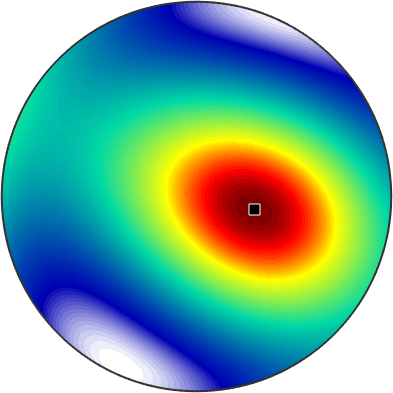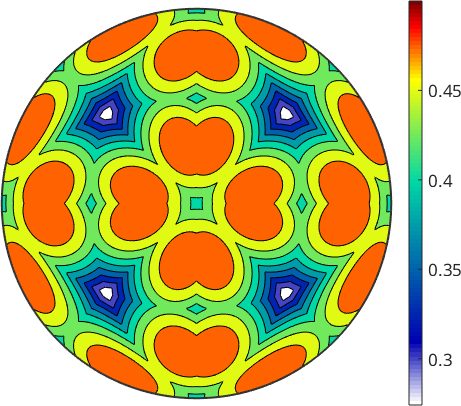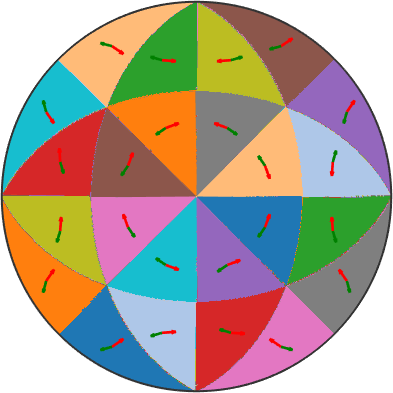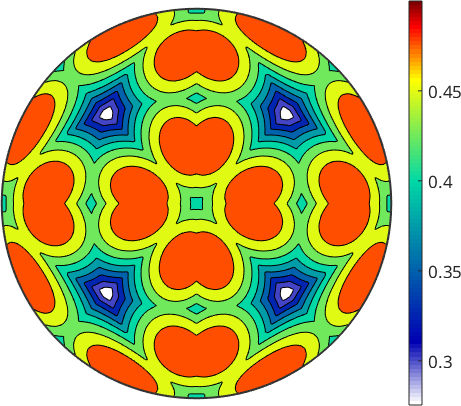Let us assume a Nickel crystal
CS = crystalSymmetry('cubic',[3.523,3.523,3.523],'mineral','Nickel')CS = crystalSymmetry
mineral : Nickel
symmetry: m-3m
elements: 48
a, b, c : 3.5, 3.5, 3.5Since Nickel is fcc a dominant slip system is given by the slip plane normal
n = Miller(1,1,1,CS,'hkl')n = Miller (Nickel)
h k l
1 1 1and the slip direction (which needs to be orthogonal)
d = Miller(0,-1,1,CS,'uvw')d = Miller (Nickel)
u v w
0 -1 1For tension in direction 123
r = normalize(vector3d(1,2,3))r = vector3d (y↑→x)
x y z
0.267261 0.534522 0.801784the Schmid factor for the slip system [0-11](111) is defined by
tau = dot(d,r,'noSymmetry') * dot(n,r,'noSymmetry')tau =
0.4286The same computation can be performed by defining the slip system as an MTEX variable
sS = slipSystem(d,n)sS = slipSystem (Nickel)
u v w | h k l CRSS
0 -1 1 1 1 1 1and using the command SchmidFactor
sS.SchmidFactor(r)ans =
0.1750Omitting the tension direction r the command SchmidFactor returns the Schmid factor as a spherical function
SF = sS.SchmidFactor
% plot the Schmid factor in dependency of the tension direction
plot(SF)
% find the tension directions with the maximum Schmid factor
[SFMax,pos] = max(SF)
% and annotate them
annotate(pos)SF = S2FunHarmonic (y↑→x)
bandwidth: 4
antipodal: true
SFMax =
0.5000
pos = vector3d (y↑→x)
antipodal: true
x y z
0.40836 -0.0917061 0.908203
Stress Tensor
Instead by the tension direction the stress might be specified by a stress tensor
sigma = stressTensor.uniaxial(vector3d.Z)sigma = stressTensor (y↑→x)
rank: 2 (3 x 3)
0 0 0
0 0 0
0 0 1Then the Schmid factor for the slip system sS and the stress tensor sigma is computed by
sS.SchmidFactor(sigma)ans =
0.4082Active Slip System
In general a crystal contains not only one slip system but at least all symmetrically equivalent ones. Those can be computed with
sSAll = sS.symmetrise('antipodal')sSAll = slipSystem (Nickel)
size: 12 x 1
u v w | h k l CRSS
0 -1 1 1 1 1 1
1 0 -1 1 1 1 1
-1 1 0 1 1 1 1
-1 1 0 1 1 -1 1
-1 0 -1 1 1 -1 1
0 -1 -1 1 1 -1 1
0 -1 1 -1 1 1 1
-1 0 -1 -1 1 1 1
-1 -1 0 -1 1 1 1
1 0 -1 1 -1 1 1
-1 -1 0 1 -1 1 1
0 -1 -1 1 -1 1 1The option antipodal indicates that Burgers vectors in opposite direction should not be distinguished. Now
tau = sSAll.SchmidFactor(r)tau =
Columns 1 through 7
0.1750 -0.3499 0.1750 0.0000 -0.0000 -0.0000 0.1166
Columns 8 through 12
-0.4666 -0.3499 -0.1166 -0.1750 -0.2916returns a list of Schmid factors and we can find the slip system with the largest Schmid factor using
[tauMax,id] = max(abs(tau))
sSAll(id)tauMax =
0.4666
id =
8
ans = slipSystem (Nickel)
u v w | h k l CRSS
-1 0 -1 -1 1 1 1The above computation can be easily extended to a list of tension directions
% define a grid of tension directions
r = plotS2Grid('resolution',0.5*degree,'upper');
% compute the Schmid factors for all slip systems and all tension
% directions
tau = sSAll.SchmidFactor(r);
% tau is a matrix with columns representing the Schmid factors for the
% different slip systems. Lets take the maximum row-wise
[tauMax,id] = max(abs(tau),[],2);
% visualize the maximum Schmid factor
contourf(r,tauMax)
mtexColorbar
We may also plot the index of the active slip system
pcolor(r,id)
mtexColorMap(vega20(12))
and observe that within the fundamental sectors the active slip system remains the same. We can even visualize the the plane normal and the slip direction
% if we omit the option antipodal we can distinguish
% between the opposite burger vectors
sSAll = sS.symmetrise
% take as directions the centers of the fundamental regions
r = symmetrise(CS.fundamentalSector.center,CS);
% compute the Schmid factor
tau = sSAll.SchmidFactor(r);
% here we do not need to take the absolute value since we consider both
% burger vectors +/- b
[~,id] = max(tau,[],2);
% plot active slip plane in red
hold on
quiver(r,sSAll(id).n,'LineWidth',2,'Color','r');
% plot active slip direction in green
hold on
quiver(r,sSAll(id).b.normalize,'LineWidth',2,'Color','g');
hold offsSAll = slipSystem (Nickel)
size: 24 x 1
u v w | h k l CRSS
0 -1 1 1 1 1 1
1 0 -1 1 1 1 1
-1 1 0 1 1 1 1
0 1 -1 1 1 1 1
-1 0 1 1 1 1 1
1 -1 0 1 1 1 1
-1 1 0 1 1 -1 1
-1 0 -1 1 1 -1 1
0 -1 -1 1 1 -1 1
1 -1 0 1 1 -1 1
1 0 1 1 1 -1 1
0 1 1 1 1 -1 1
0 -1 1 -1 1 1 1
-1 0 -1 -1 1 1 1
-1 -1 0 -1 1 1 1
0 1 -1 -1 1 1 1
1 0 1 -1 1 1 1
1 1 0 -1 1 1 1
1 0 -1 1 -1 1 1
-1 -1 0 1 -1 1 1
0 -1 -1 1 -1 1 1
-1 0 1 1 -1 1 1
1 1 0 1 -1 1 1
0 1 1 1 -1 1 1
If we perform this computation in terms of spherical functions we obtain
% omitting |r| gives us a list of 12 spherical functions
tau = sSAll.SchmidFactor
% now we take the max of the absolute value over all these functions
contourf(max(abs(tau),[],1),'upper')
mtexColorbartau = S2FunHarmonic (y↑→x)
size: 24 x 1
bandwidth: 4
antipodal: true
The Schmid factor for EBSD data
So far we have always assumed that the stress tensor is already given relatively to the crystal coordinate system. Next, we want to examine the case where the stress is given in specimen coordinates and we know the orientation of the crystal. Let's import some EBSD data and compute the grains
mtexdata csl
% take some subset
ebsd = ebsd(ebsd.inpolygon([0,0,200,50]))
grains = calcGrains(ebsd);
grains = smooth(grains,5);
plot(ebsd,ebsd.orientations,'micronbar','off')
hold on
plot(grains.boundary,'linewidth',2)
hold offebsd = EBSD (y↑→x)
Phase Orientations Mineral Color Symmetry Crystal reference frame
0 5 (0.0032%) notIndexed
-1 154107 (100%) iron LightSkyBlue m-3m
Properties: ci, error, iq
Scan unit : um
X x Y x Z : [0, 511] x [0, 300] x [0, 0]
Normal vector: (0,0,1)
ebsd = EBSD (y↑→x)
Phase Orientations Mineral Color Symmetry Crystal reference frame
-1 10251 (100%) iron LightSkyBlue m-3m
Properties: ci, error, iq
Scan unit : um
X x Y x Z : [0, 200] x [0, 50] x [0, 0]
Normal vector: (0,0,1)
We want to consider the following slip systems
sS = slipSystem.fcc(ebsd.CS)
sS = sS.symmetrise;sS = slipSystem (iron)
u v w | h k l CRSS
0 1 -1 1 1 1 1Since, those slip systems are in crystal coordinates but the stress tensor is in specimen coordinates we either have to rotate the slip systems into specimen coordinates or the stress tensor into crystal coordinates. In the following sections we will demonstrate both ways. Lets start with the first one
% rotate slip systems into specimen coordinates
sSLocal = grains.meanOrientation * sSsSLocal = slipSystem (y↑→x)
CRSS: 1
size: 71 x 24These slip systems are now arranged in matrix form where the rows correspond to the crystal reference frames of the different grains and the rows are the symmetrically equivalent slip systems. Computing the Schmid factor we end up with a matrix of the same size
% compute Schmid factor
sigma = stressTensor.uniaxial(vector3d.Z)
SF = sSLocal.SchmidFactor(sigma);
% take the maximum along the rows
[SFMax,active] = max(SF,[],2);
% plot the maximum Schmid factor
plot(grains,SFMax,'micronbar','off','linewidth',2)
mtexColorbar location southoutsidesigma = stressTensor (y↑→x)
rank: 2 (3 x 3)
0 0 0
0 0 0
0 0 1
Next we want to visualize the active slip systems.
% take the active slip system and rotate it in specimen coordinates
sSactive = grains.meanOrientation .* sS(active);
hold on
% visualize the trace of the slip plane
quiver(grains,sSactive.trace,'color','b')
% and the slip direction
quiver(grains,sSactive.b,'color','r')
hold off
We observe that the Burgers vector is in most case aligned with the trace. In those cases where trace and Burgers vector are not aligned the slip plane is not perpendicular to the surface and the Burgers vector sticks out of the surface.
Next we want to demonstrate the alternative route
% rotate the stress tensor into crystal coordinates
sigmaLocal = inv(grains.meanOrientation) * sigmasigmaLocal = stressTensor (iron)
size: 71 x 1
rank: 2 (3 x 3)This becomes a list of stress tensors with respect to crystal coordinates - one for each grain. Now we have both the slip systems as well as the stress tensor in crystal coordinates and can compute the Schmid factor
% the resulting matrix is the same as above
SF = sS.SchmidFactor(sigmaLocal);
% and hence we may proceed analogously
% take the maximum along the rows
[SFMax,active] = max(SF,[],2);
% plot the maximum Schmid factor
plot(grains,SFMax)
mtexColorbar
% take the active slip system and rotate it in specimen coordinates
sSactive = grains.meanOrientation .* sS(active);
hold on
% visualize the trace of the slip plane
quiver(grains,sSactive.trace,'color','b')
% and the slip direction
quiver(grains,sSactive.b,'color','r')
hold off
Strain-based analysis on the same data set
eps = strainTensor(diag([1,0,-1]))
epsCrystal = inv(grains.meanOrientation) * eps
[M, b] = calcTaylor(epsCrystal, sS);
plot(grains,M,'micronbar','off')
mtexColorbar southoutsideeps = strainTensor (y↑→x)
type: Lagrange
rank: 2 (3 x 3)
1 0 0
0 0 0
0 0 -1
epsCrystal = strainTensor (iron)
size: 71 x 1
type: Lagrange
rank: 2 (3 x 3)
[ bMax , bMaxId ] = max( b , [ ] , 2 ) ;
sSGrains = grains.meanOrientation .* sS(bMaxId) ;
hold on
bVec = sSGrains.b; bVec.z = 0;
quiver ( grains , bVec)
quiver ( grains , sSGrains.trace)
hold off